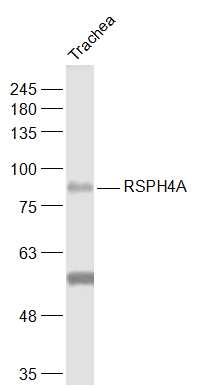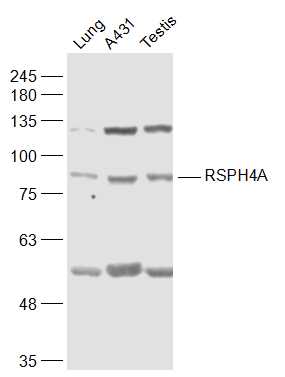
Rabbit Anti-RSPH4A antibody
CILD11; dJ412I7.1; Radial spoke head protein 4 homolog A; Radial spoke head-like protein 3; RSH4A_HUMAN; RSHL3; Rsph4a; RSPH6B; A230081C05.
View History [Clear]
Details
Product Name RSPH4A Chinese Name Kartagener综合征相关蛋白RSHL3抗体 Alias CILD11; dJ412I7.1; Radial spoke head protein 4 homolog A; Radial spoke head-like protein 3; RSH4A_HUMAN; RSHL3; Rsph4a; RSPH6B; A230081C05. Research Area Cell biology Developmental biology Neurobiology Signal transduction Cytoskeleton Extracellular matrix Immunogen Species Rabbit Clonality Polyclonal React Species Human, Mouse, (predicted: Rat, Chicken, Dog, Pig, Cow, Horse, Sheep, ) Applications WB=1:500-2000 ELISA=1:5000-10000 IHC-P=1:100-500 IHC-F=1:100-500 ICC=1:100-500 IF=1:100-500 (Paraffin sections need antigen repair)
not yet tested in other applications.
optimal dilutions/concentrations should be determined by the end user.Theoretical molecular weight 81kDa Cellular localization cytoplasmic Form Liquid Concentration 1mg/ml immunogen KLH conjugated synthetic peptide derived from human RSPH4A/RSHL3: 435-482/716 Lsotype IgG Purification affinity purified by Protein A Buffer Solution 0.01M TBS(pH7.4) with 1% BSA, 0.03% Proclin300 and 50% Glycerol. Storage Shipped at 4℃. Store at -20 °C for one year. Avoid repeated freeze/thaw cycles. Attention This product as supplied is intended for research use only, not for use in human, therapeutic or diagnostic applications. PubMed PubMed Product Detail RSHL3 is predicted to be a component of the radial spoke head based on homology with proteins in the biflagellate alga Chlamydomonas reinhardtii and other ciliates. RSHL3 (radial spoke head-like protein 3), also known as radial spoke head protein 4 homolog A, is a 716 amino acid protein that belongs to the flagellar radial spoke RSP4/6 family. Mutations in the RSHL3 gene cause primary ciliary dyskinesia 1, a disease arising from dysmotility of motile cilia and sperm. Existing as three alternatively spliced isoforms, the RSHL3 gene contains 6 exons, is conserved in chimpanzee, dog, cow, mouse, rat, chicken, zebrafish, fruit fly and P.falciparum, and maps to human chromosome 6q22.1.
Function:
Probable component of the axonemal radial spoke head. Radial spokes are regularly spaced along cilia, sperm and flagella axonemes. They consist of a thin stalk which is attached to a subfiber of the outer doublet microtubule, and a bulbous head which is attached to the stalk and appears to interact with the projections from the central pair of microtubules.
Subcellular Location:
Cytoplasm; cytoskeleton; cilium axoneme. Radial spoke.
Tissue Specificity:
Defects in RSPH4A are the cause of primary ciliary dyskinesia type 11 (CILD11) [MIM:612649]. CILD is an autosomal recessive disorder characterized by axonemal abnormalities of motile cilia. Respiratory infections leading to chronic inflammation and bronchiectasis are recurrent, due to defects in the respiratory cilia; reduced fertility is often observed in male patients due to abnormalities of sperm tails. Half of the patients exhibit situs inversus, due to dysfunction of monocilia at the embryonic node and randomization of left-right body asymmetry. Primary ciliary dyskinesia associated with situs inversus is referred to as Kartagener syndrome.
DISEASE:
Defects in RSPH4A are the cause of primary ciliary dyskinesia type 11 (CILD11) [MIM:612649]. CILD is an autosomal recessive disorder characterized by axonemal abnormalities of motile cilia. Respiratory infections leading to chronic inflammation and bronchiectasis are recurrent, due to defects in the respiratory cilia; reduced fertility is often observed in male patients due to abnormalities of sperm tails. Half of the patients exhibit situs inversus, due to dysfunction of monocilia at the embryonic node and randomization of left-right body asymmetry. Primary ciliary dyskinesia associated with situs inversus is referred to as Kartagener syndrome.
Similarity:
Belongs to the flagellar radial spoke RSP4/6 family.
SWISS:
Q5TD94
Gene ID:
345895
Database links:Entrez Gene: 345895 Human
Omim: 612647 Human
SwissProt: Q5TD94 Human
Unigene: 160380 Human
Kartagener综合征:由下列三联症组成,支气管扩张、鼻窦炎或鼻息肉及内脏反位(主要是右位心)。若仅具备内脏反位及支气管扩张两项,则为不全性Kartagener综合征。常合并其他先天性畸形。其病因是由于全身纤毛先天性缺乏轴丝臂,引起纤毛活动力丧失、黏液纤毛运输功能障碍,分泌物和细菌潴留而发生持续性感染长期存在所致。以学龄儿童及青少年多发,有家族史。主要症状为随年龄加重的咳嗽、咳痰和咯血,晨起明显,易患感冒及肺炎,常见体征为发绀和杵状指。Product Picture
Trachea (Mouse) Lysate at 40 ug
Primary: Anti-RSPH4A (SL11472R) at 1/1000 dilution
Secondary: IRDye800CW Goat Anti-Rabbit IgG at 1/20000 dilution
Predicted band size: 81 kD
Observed band size: 81 kD
Bought notes(bought amounts latest0)
No one bought this product
User Comment(Total0User Comment Num)
- No comment




 +86 571 56623320
+86 571 56623320
 +86 18668110335
+86 18668110335

